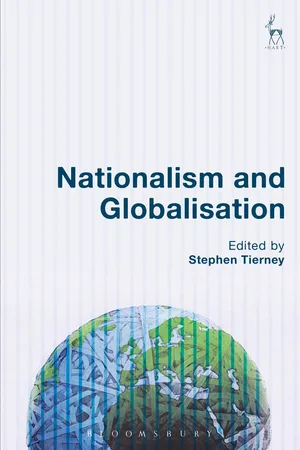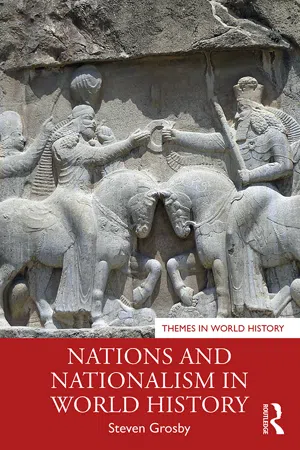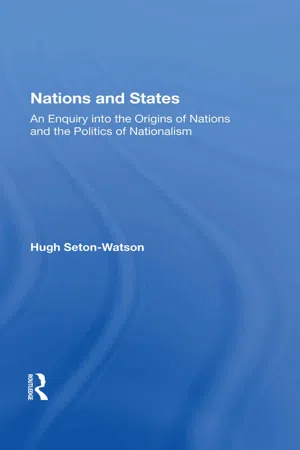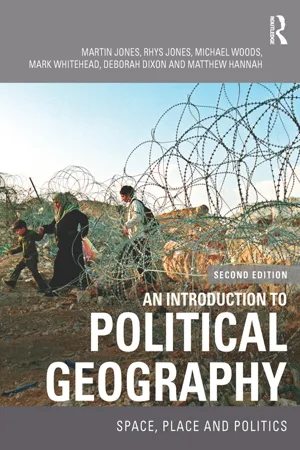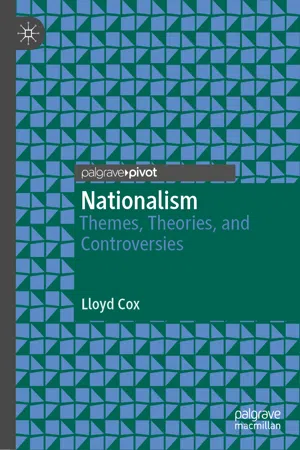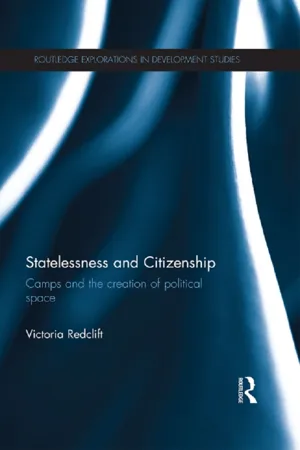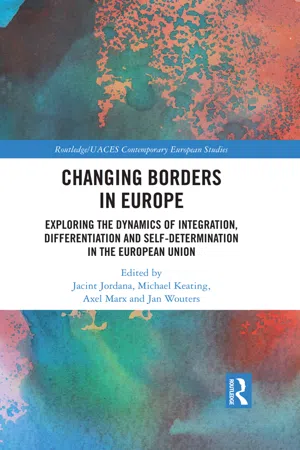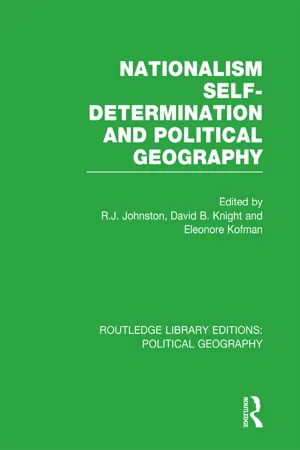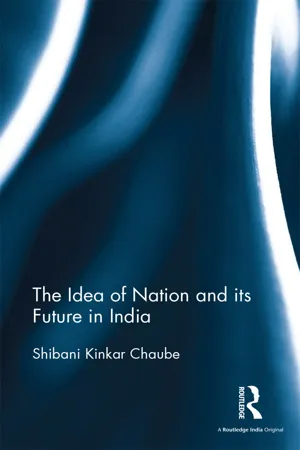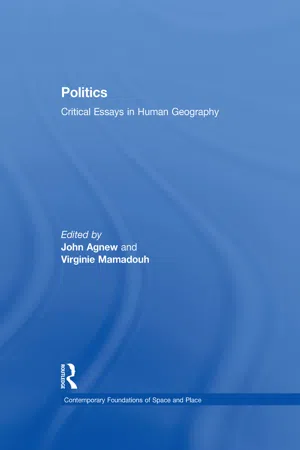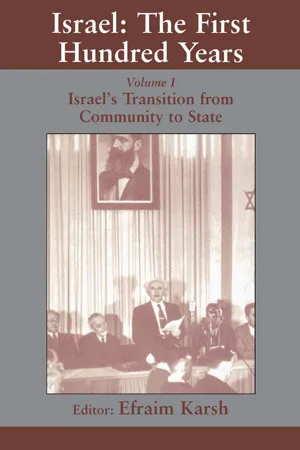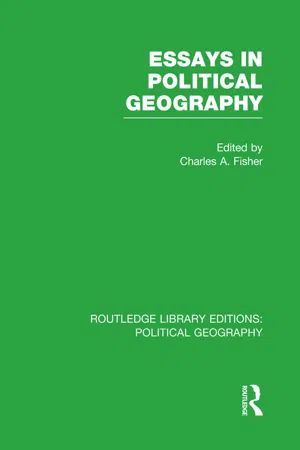Geography
Nation vs Nation State
A nation is a group of people who share a common identity, culture, and history, while a nation-state is a political entity that governs a specific territory and is comprised of a single nation. Not all nations have their own nation-state, as some may be part of a larger political entity, while some nation-states may be home to multiple nations.
Written by Perlego with AI-assistance
Related key terms
12 Key excerpts on "Nation vs Nation State"
- eBook - ePub
- Stephen Tierney, Stephen Tierney(Authors)
- 2015(Publication Date)
- Hart Publishing(Publisher)
I. State and NationThe concept of the nation-state is fundamental to both political science and law but it is notoriously difficult to define. In some national traditions, the compound word is redundant, as state and nation are almost synonyms. For many scholars of international relations, the nation-state is defined by reference to sovereignty, as the fundamental building block of global order. In political theory, nation and state are usually distinguished, so that a nation-state is one in which nation and state are co-terminous, as opposed to complex states containing more than one nation, or situations where a nation covers more than one state. The doctrine of national self-determination is then a normative principle according to which nations should be allowed a state of their own. As the nation is the ‘people’ or demos underpinning democracy, this provides a principle of popular self-determination in conditions of freedom. Yet, as Ivor Jennings famously pointed out, before the people can self-determine, someone has to define who the people are.1This encounters two principal difficulties. First, the definition of a nation or people is notoriously slippery and often subjective. While political theorists often take the nation for granted,2 sociologists are practically unanimous in seeing it as socially constructed and usually contested.3 Second, even if we could define the nation scientifically, how can we draw normative implications from this? These difficulties were often brushed aside in the heyday of the nation-state, when the legitimacy of existing states was largely taken for granted. It was those who advocated changing boundaries or setting up new states who had to make their case and it was always easy to dismiss this as somehow ‘artificial’ or as violating legal norms and impossible to operationalise universally. Hence, doctrines of self-determination tended to be defined rather narrowly, to be applied in exceptional circumstances.4 - eBook - ePub
- Steven Grosby(Author)
- 2021(Publication Date)
- Routledge(Publisher)
No two nations are alike, as the characteristics of one nation differ from those of another. The territory of one nation may be distinguished by its inhabitants from the territory of another nation by language; or the territory of one nation may be distinguished by its inhabitants from another by religion; or the territory of a nation may be distinguished by legal and political traditions, as the inhabitants of one nation may conceive its territory as a land of liberty, for example, the United States of America, while another nation may have a long tradition of a king, for example, Thailand, or an emperor, for example, Japan. But what all nations have in common is an image of a territory. That there are these different characteristics is the reason why an expansive definition of the nation as a relatively extensive, yet bounded territorial community of kinship is required. With that definition, the historian has a category that proves analytically useful in (1) differentiating nation from other social relations, for example, a religious community or a linguistic community, even though language and religion may very well have an influence on the development of a nation; and (2) combining different societies from different parts of the world and from different historical periods because of the similar character of territorial kinship.There is, however, still need for a further differentiation, for the historian comes across territorial communities of different geographical dimension. There are territorial relations smaller than nations, for example, cities and city-states, where the individual understands himself or herself as, in antiquity, an Athenian, or as, today, a Berliner or a New Yorker. There are also territorial relations larger than nations, specifically, empires, where the individual may understand himself or herself as, in antiquity, a Roman. The category nation is distinguished from these other territorial relations by its dimension. A nation is geographically larger than a city, as its territory encompasses several cities. It is geographically smaller than an empire that, qua empire, encompasses many nations. The nation is further distinguished from an empire by having over time relatively stable borders that delimit the geographical location of its traditions into a territory and the inhabitants of that territory into a people. In contrast, the borders of an empire expand and contract depending upon military exigencies; thus, over time its territory and its inhabitants significantly change. - eBook - ePub
Nations And States
An Enquiry Into The Origins Of Nations And The Politics Of Nationalism
- Hugh Seton-watson(Author)
- 2019(Publication Date)
- Routledge(Publisher)
1Nations and NationalismThe object of this book is to examine the processes by which nations have been formed, the types of political movements which have sought to achieve what has been considered to be the national purpose, and the ways in which such movements have influenced and been influenced by the internal policies of states and the relations of states with each other.The distinction between states and nations is fundamental to my whole theme. States can exist without a nation, or with several nations, among their subjects; and a nation can be coterminous with the population of one state, or be included together with other nations within one state, or be divided between several states. There were states long before there were nations, and there are some nations that are much older than most states which exist today. The belief that every state is a nation, or that all sovereign states are national states, has done much to obfuscate human understanding of political realities. A state is a legal and political organisation, with the power to require obedience and loyalty from its citizens. A nation is a community of people, whose members are bound together by a sense of solidarity, a common culture, a national consciousness. Yet in the common usage of English and of other modern languages these two distinct relationships are frequently confused.In the United States the expression ‘throughout the nation’ simply means ‘throughout the country’. In the main European languages the words ‘international relations’ and their equivalent are used to denote the relations between states. The organisation set up at the end of the Second World War with the hope of preventing war and promoting peace between states was called ‘United Nations’, and its predecessor had been called ‘League of Nations’. But membership of both these organisations was confined in fact to governments of states. It was assumed in the age of President Wilson that states would embody nations; that the people of every state would form a nation; and that eventually, in the golden age of self-determination which was dawning, every nation would have its state. There were of course in 1918 many such states: the expression ‘nation-state’ in such cases reflected a reality. There were, however, many others, some of which became members of the League of Nations, of which this was not true. The rhetoric of Wilson was still used in the age of Roosevelt (a founding father of the United Nations, though he did not live to see it function). Many of the original members, and many who later joined it, were nation-states, but many of each category were not. The United Nations in fact has proved to be little more than a meeting place for representatives of Disunited States. The frequently heard cliché that ‘we live in an age of nation-states’ is at most a half-truth. What is arguably true is that we live in an age of sovereign states. Many people believe that state sovereignty is a major cause of international tension, and a potential cause of future wars; and that steps should be taken to diminish it. It is also often asserted that ‘the age of the nation-state is coming to an end’. The truth is less simple; the problems of sovereignty and of nationalism, of states and of nations, are not the same. There have been times when the existence of state sovereignty has been a cause of war, and others when the aspirations of nations have led to war. There have been examples in recent times of diminution of state sovereignty, and it is quite possible that there will be a growing trend in this direction. But the disappearance of state sovereignties has not caused the disappearance of nations, any more than the creation of new state sovereignties has sufficed to create new nations. Whether nations can - eBook - ePub
An Introduction to Political Geography
Space, Place and Politics
- Martin Jones, Rhys Jones, Michael Woods, Mark Whitehead, Deborah Dixon, Matthew Hannah(Authors)
- 2014(Publication Date)
- Routledge(Publisher)
Chapter 2 , it is often the case that our membership of nations – as individuals and as communities of people – makes it difficult to think about them in an objective way. This is even more of an issue since it is nigh-on impossible for any individual to escape from the grasp of nationalist discourse. Gellner (1983: 6) notes the prevalence of such a discourse when he argues that it is as if ‘a man (sic) must have a nationality as he must have a nose and two ears’. When nations are commonly viewed as ‘natural’ phenomena like this, it becomes difficult critically to analyse their form and function. A further problem arises when attempting to distinguish between states and nations. In the first part of this section, our aim is to define what we mean by nations and emphasise the difference between states and nations.According to Anthony Smith (1991: 14), a prominent writer on themes of nationalism, a nation should be viewed as a ‘named human population sharing an historic territory, common myths and historical memories, a mass, public culture, a common economy and common legal rights and duties for all members’. Although definitions of nations display slight variations in the themes that they emphasise (see below), on the whole they follow the general principles laid down by Smith. Smith’s definition draws our attention to a number of important themes. First, and crucially, all nations should possess a geographical referent in their claims to a particular territory. It is difficult to imagine a nation that does not claim access or control over a certain territory and it is this feature of nations that acts as the main justification for studying nations from a geographical perspective. We will argue in subsequent sections that territory is only one geographical theme that is of importance to nations. Others, such as place and landscape, are also highly significant. Second, Smith’s definition stresses some of the key cultural aspects of nations. Nations are said to possess a common ‘public culture’. They also emphasise common historical memories that help to engender a sense of loyalty towards the nation. It is these common cultural characteristics that enable the members of a nation to imagine the existence of this large-scale, yet close-knit, community of people, even though they will never meet all other members of the nation (Anderson 1983). It is these cultural themes that also help us to distinguish between states and nations. Whereas states are organisations that seek to control a particular territory – similar to nations – they do so in a relatively impersonal manner. States, per se , do not attempt to stress the cultural commonalities that exist within and between the state’s citizens. Nations, on the other hand, are conceived of as communities that are characterised by common ties of custom, history and culture and a connection to a certain territory. It is when both of these institutions combine, of course, that the powerful organisation of the nation-state is formed. Third, Smith emphasises the role that certain legal and economic processes play in forging a nation. Once again, this draws us near to definitions of the state (see Chapter 2 - eBook - ePub
Nationalism
Themes, Theories, and Controversies
- Lloyd Cox(Author)
- 2020(Publication Date)
- Palgrave Macmillan(Publisher)
Guibernau defines the nation as ‘a human group conscious of forming a community, sharing a common culture, attached to a clearly demarcated territory, having a common past and a common project for the future and claiming the right to rule itself’ (1996 : 47). From a different theoretical perspective, Anthony Smith arrives at a similar definition. For him, a nation can be defined as ‘a named human population which shares myths and memories, a mass public culture, a designated homeland, economic unity and equal rights and duties for all members’ (1995 : 56–57). Similarly, Hroch defines the nation as ‘a large social group integrated not be one but by a combination of several kinds of social relationships (economic, political, linguistic, cultural, religious, geographical, historical), and their subjective reflection in collective consciousness …’ (1996 : 79). In each of these definitions, the specific features that are said to constitute a nation are not, for my purposes here, as important as the general approach. This is an approach that presumes that there are real, substantial collectives to which the term nation refers, and that these collectives can be identified with reference to a number of objective characteristics. There are a number of problems with this approach. To begin with, it has been criticized for reifying the nation. That is, it treats the nation as a real, observable entity, which has the continuity of a subject and which embodies the distinctive character, culture, and political aspirations of a clearly delineated people (Brubaker 1996, 2006 : 15). This obscures the contingency of the formation of national phenomena, as well as suppressing the internal cleavages and variability in their subsequent development. While I do not concur with all of the assumptions behind this criticism (for reasons outlined below), it is right to be sceptical of the incautious use of the term nation to refer to some observable, clearly delineated community - eBook - ePub
Statelessness and Citizenship
Camps and the Creation of Political Space
- Victoria Redclift(Author)
- 2013(Publication Date)
- Routledge(Publisher)
The issues raised in this study question such claims. Brubaker argues that those who herald the emerging postnational age are too hasty in abandoning the nation-state, since citizenship continues to be ‘a powerful instrument of social closure’ (1992: x). The Eurocentric nature of citizenship typologies, and the historical specificity of citizenship in meaning and value, will be explored at greater depth in this and the following chapters. As these reveal, national belonging may not be the universal panacea it is often claimed to be, but it nonetheless carries real material consequences and statelessness represents a source of severe human insecurity that can ultimately be effectively addressed only by states themselves (Sokoloff 2005). The case in question reminds us that the key structure within which the socio-political community relates remains the nation-state – inclusion or exclusion from which lays the foundations for opportunities and expectations. The perfect overlap between state and nation may no longer exist, but this ideal is still salient in public imagination and political discourse, and the pressure of this public imaginary is profound.In many ways this relationship between state and nation frames historical consciousness in modern society. While the state is a political entity, a collection of institutions organised around the intentionality of control, the nation (assuming somewhat different meanings in different discourses) is variously combined with notions of ‘common origin’, ‘common destiny’ and ‘common solidarity’ to designate a collection of people presumed to share a ‘common culture’ (Brah 1996). The state is here the political embodiment of the nation, and the nation is the cultural reproduction of state control. Citizenship is, therefore, a political concept deriving from people’s relationship to the state, while nationality is in essence a cultural concept deriving from peoples relationship to each other. The two are analytically distinct, belonging to different spheres of meaning and activity, and state-ness and nation-ness need not be, and increasingly are not, aligned (McCrone and Kiely 2000).Although the death of the nation has long been prophesied, it could still be argued that nation-ness remains ‘the most universally legitimate value in the political life of our time’ (Anderson 1983: 3). The strength of the connection between culture, identity and the nation-state has been manipulated throughout history, and the region of Bengal is no exception. Unity and continuity are emphasised to cover the fragility of new nations in the interests of producing a picture of a coherent populace, and at the level of the nation-state the ‘institutionalisation of homogeneity’ is acute (Goldberg 2002). The boundaries of citizenship, are, in part, rationalised through a national history and state memory that preserves these connections. In this way, history is often less a response to the past than a response to the requirements of the present, or in fact a struggle for control of the future (Norval 2001).26 - eBook - ePub
Changing Borders in Europe
Exploring the Dynamics of Integration, Differentiation and Self-Determination in the European Union
- Jacint Jordana, Michael Keating, Axel Marx, Jan Wouters, Jacint Jordana, Michael Keating, Axel Marx, Jan Wouters(Authors)
- 2018(Publication Date)
- Routledge(Publisher)
From the early twentieth century, a key principle of international political order was that of national self-determination, beginning in the nineteenth-century rise of nationalism and crystallized in Woodrow Wilson’s precepts at the end of the First World War. As long as existing states could be assumed to be national, self-determination raised few problems. Rather, it could sustain political order and legitimacy; it is still used in this way by defenders of the actual states. Exceptions could be made during the mid-twentieth century for overseas colonies (the salt water doctrine), which could themselves become independent nation-states. More difficult is the case of nationality movements within existing states or the great European empires (Habsburg, Ottoman and Romanov), which grappled with their nationality’s questions in the nineteenth century and collapsed in the aftermath of the First World War. As Ivor Jennings (1956: 55) famously put it:Nearly forty years ago a Professor of Political Science, who was also President of the United States, enunciated a doctrine which was ridiculous but which was widely accepted as a sensible proposition, the doctrine of self-determination. On the surface it seemed reasonable, let the people decide. It was in fact ridiculous because the people cannot decide until someone decides who are the people.The nation-state thus provides a less firm foundation for political order than the political and legal sciences have often assumed. In some ways, it can be seen as a myth, a powerful story whose force is not dependent on its factual accuracy but more on its uses. The term itself is used in very different ways. In the discipline of international relations, it refers to a sovereign state – although sometimes states are seen as sovereign by definition. In comparative politics, it refers to the situation in which the state and the nation are congruent, as opposed to plurinational states where the relationship is contested. In either case, the nation-state is always a claim, a normatively charged aspiration, which may to a greater or less extent be realizable.In the early twenty-first century, as the nation-state has lost much of its functional capacity and its mystique, its inherently conditional and contested nature is ever more visible. States are reconfiguring and rescaling in response to internal and external changes (King and Le Galès, 2017; Leibfried et al., 2015; Keating, 2013).Rescaling
In the late twentieth century, coinciding with the end of the Cold War, there were debates about the end of territory (Badie, 1995) and the end of history (Fukuyama, 1992). This was the very apotheosis of modernization theory, in which the very foundations of the differentiated political order would disappear into an undifferentiated global finality. History, of course, continued. As for territory, what was often being described was not its termination but rather the end of the nation-state and the unique definer and controller of territory. Political, economic and social orders were, rather, reterritorializing but at new scales, above, below and across states. The coincidence of state, governing order, economy, society and identity could no longer be taken for granted (Jessop et al., 2008; Keating, 2013). - R. J. Johnston, David Knight, Eleonore Kofman(Authors)
- 2014(Publication Date)
- Routledge(Publisher)
G. Smith, 1979 ; Williams, 1982 , 1985 ; Orridge and Williams, 1982 ). For Agnew (1987) , the way that nationalism has been defined and examined in history and social science has not allowed for geographical analysis. Yet Williams (1985 , pp. 340–50) lists five areas in which geographers have extended, or could extend, the analysis of nationalism_ 1) the national construction of social space; 2) uneven development and nationalism; 3) the secular intelligentsia; 4) structural preconditions and triggering factors; and 5) ecological analysis.Before we embark on an exploration of what geographers can offer to the study of nationalism, especially the appreciation of territory as the basis and political resource of nation-building in a world of states, we shall first clarify what is meant by nationalism and self-determination.Varieties of Nationalism
Given its varieties and complexity it is not surprising that definitions of nationalism have attempted to combine its multiple aspects. Each of these aspects is constructed and does not constitute a ‘natural’ element. Thus Emerson (1960) defined nationalism asa community of people who feel that they belong together in the double sense that they share deeply significant elements of a common heritage and that they have a common destiny for the future … [it] has become the body which legitimizes the state (pp. 95–6).The implication is that a nation is historically derived – the past produces the present and leads to the future. More recent definitions have tended to emphasise the relationship between nationalism and the acquisition and sustaining of a state of one’s own (Worsley, 1984 , p. 248). It is increasingly recognised that nationalism is a political principle, that its ability to achieve its objectives involves practical politics (see Hedges chapter 7 ), and that the constituent cultural elements are not given and fixed for all time. For example, Basque nationalism has shifted from the primordial basis of its earliest form at the end of the nineteenth century to a more territorial form in its recent manifestations (Linz, 1985- eBook - ePub
- Shibani Kinkar Chaube(Author)
- 2016(Publication Date)
- Routledge India(Publisher)
Smith distinguishes between national sentiment and nationalism as the former is ‘more relative than the latter’. He finds the statist definition of nation ‘rather misleading’ as the object of nationalist devotion is the nation, not the state although after independence they may coincide (Smith, 1983: 174ff.) and as it ignores the cultural aspect. He also admits that strictly speaking ethnicity refers to common descent but stresses that, though nations may claim to have founders, they do not claim common ancestors. Smith stresses seven features of nation: (1) Cultural difference (i.e. the similarity–dissimilarity pattern: members are alike in respects in which they differ from non-members). (2) Territorial contiguity with free mobility throughout. (3) A relatively large scale of size and population. (4) External political relations of conflict and alliance with similar groups. (5) Considerable group sentiment and loyalty. (6) Direct membership with equal citizenship rights. (7) Vertical economic integration around a common system of labour (Smith, 1983: 186). Of these features, cultural difference and territorial mobility are common with extended kinship and ethnie ; but large size in-group sentiment and external relations are common with ethnie only (Smith, 1986: 189). Culture and Territory The goal of nationalism to unite the territorial boundary of state with cultural boundary within the framework of sovereignty was never fully achieved. Absorption of territory of alien cultural groups was the practice of empires. In democracies, there is a temptation to assimilate territories inhabited by kindred people, something that becomes unachievable due to diplomatic and other considerations. Expulsion of ‘alien’ ethnocultural groups is more common in democratic regimes with the purpose of ethnic cleansing (Israel, post-partition India and Pakistan, Sri Lanka, Burma, several African countries) - eBook - ePub
Politics
Critical Essays in Human Geography
- Virginie Mamadouh, John Agnew(Authors)
- 2017(Publication Date)
- Routledge(Publisher)
The different roles and functions of territoriality at different spatial scales have provided an important focus for some political geographers (Sack, 1986; Johnston, 1991). Scale plays an important part in the process of boundary construction, while national boundaries can have a differential impact at different scales of analysis (Minghi, 1963; Paasi, 1996a). State boundaries, for instance, are not universal phenomena in their territorial meanings and functions, but exist in varying concrete and symbolic forms simultaneously as part of the international geopolitical landscape, the nation-state system and local life. The everyday life meanings, for their part, differ crucially in border areas and elsewhere in states. Boundaries and territoriality are therefore contextual. At the global scale, this context is the geopolitical and economic landscape of the world, while, at the scale of the state, it is the continual nation-building process which manifests itself in different social practices. The third significant scale is the sphere of everyday life experience (Agnew, 1987; Taylor, 1993; Smith, 1995; Paasi, 1996a), where the meanings of (state) boundaries are ultimately reproduced and contested. The state makes a difference as far as boundary functions are concerned. Taylor (1994) argues that the state as power container tends to preserve existing boundaries; as a wealth container it tends towards larger territories; and, finally, as a cultural container it tends towards smaller territories.As far as the basic parameters of the global geopolitical landscape are concerned, and in spite of the globalization argument, the state still appears to provide the basic frame for discussing boundaries. We five in a world of some 190 states. Our world is a world of ‘territorial containers’ but it is also ‘interterritorial’ – almost every portion of the settled ecumene is part of the sovereign territory of some state (Taylor, 1995). The relationship between state and nation has become increasingly complicated, partially evidenced by the increase in the number of separate entities: at the turn of the 1980s, there were some 160 states; at the turn of the 1960s, 90; and before the second world war, fewer than 70. In the contemporary world, there exist 800 nationalist movements or groups and several thousand cultures, among and between whom new questions regarding territorial and social identity may continually arise (Rapoport, 1996). Thus questions of national identity are also tied up with different spatial scales, as ethnic territories become smaller and smaller.Whereas national identities are expressions of general sociospatial consciousness, at the local level and in daily life, dimensions of identity and the meanings of history and heritage become complicated. The national narratives of state borders, therefore, may have different meanings in different contexts. Local experience and folklore mediate the national forms of identity, and it is impossible to understand the latter without knowledge of the former (Cohen, 1982; Paasi, 1996a). Clearly people come to terms with a relatively small number of representations of general sociospatial consciousness in their daily life and local experience, and most of these are representations set forth by the media and education. Billig (1995) argues that, in local experience, these national symbols become expressions of banal nationalism that are ‘flagged’ and lived in daily life. This also holds true in the case of boundaries. For people living in border areas, boundaries are an essential part of the activities and discourses of daily life, which are not necessarily translated into the collective and historical meanings that manifest themselves in the more general sociospatial consciousness and its concrete manifestations, such as national literature, monuments, curricula, etc. For people living elsewhere in states, boundaries are typically ‘present’ in the form of this general social consciousness (Paasi, 1996a). Local contexts therefore present several theoretical and methodological challenges for boundary studies, not least in the case of research methods, where qualitative, interpretative and ethnographic methods may be useful. This also provides a framework for bridging the gap between political geography and contemporary approaches within cultural research (Cohen, 1982; 1986; Sahlins, 1989; Krishna, 1996). - eBook - ePub
Israel: the First Hundred Years
Volume I: Israel's Transition from Community to State
- Efraim Karsh(Author)
- 2014(Publication Date)
- Routledge(Publisher)
For Charles Tilly, too, the close relationships between states, warfare and treaty-making created the context and format of modern nations; just as it is the inter-state system with its intricate balance of power that, for Orridge and Navarri, provided the essential dynamic behind state-making and nation-building. Similarly, Anthony Giddens sees the nation-state as a ‘bordered power-container’, which emerges in the shadow of the centralized, reflexive modern state; with nationalism as little more than the psychological concomitant of the territorially delimited and sovereign administrative state. 2 HOMELAND AND ETHNOSCAPE This view has much to commend it, as far as it goes. Not only does it locate the roots of national conflict firmly in the domain of politics; it helps to explain in so many cases why quite arbitrary colonial boundaries and institutions have retained their hold and viability, despite many challenges. It also allows us to relate issues of international relations such as interstate diplomacy, trade rivalries and war to the mobilization of mixed populations and the forging of unitary national states. But this perspective also has its drawbacks. For one thing, it fails to account for the equally numerous examples of successful separatist ethnic nationalisms in Eastern Europe, the Caucasus and Central Asia, not to mention the many politically less successful, but protracted and persistent ethnic and regional movements like the southern Sudanese, Kurds, Tamils and Sikhs. Even where such ethnic nationalisms do not aim for outright independence, as with the ethnic autonomy movements of Western Europe, their understandings and loyalties spring from the myths, memories and symbols of an ethnic past and vernacular culture, which they feel are insufficiently recognized and valued by the dominant ethnic majority and the institutions of state - eBook - ePub
- Charles A. Fisher(Author)
- 2016(Publication Date)
- Routledge(Publisher)
1 Behind these movements has lurked continually the political force of ‘nationalism’, although this has not always been evidently present. While ‘nationality’ has been a recognizable fact of the more developed societies throughout history – a Roman citizen might well have been, for example, a Briton, a Gaul or a Greek – the ‘nation’, as the focus of political sentiment and ambition, is a relatively new development, and ‘nationalism’, the political expression of a national group, was long held in check as a dangerous and politically fissiparous force. Vigorous and vociferous nationalism no doubt goes far to explain the emergence of many new states, the peoples of which were formerly contained within multi-national empires, in every continent. However, the principle ‘one nation one state’ has not been the only principle applied. Many of the new states are markedly multi-national (for example Yugoslavia, Czechoslovakia, India and Malaysia), and in Africa it has seldom been clear that nationalism applies, given the existence of tribally organized groups and of nationalities not yet transmuted into self-conscious nations.TABLE 5.1: THE NUMBER OF INDEPENDENT STATES BY CONTINENTSThe disintegrative effect of decolonization leaps to the eye and can be shown by arithmetic, simple and yet not without the difficulty of deciding what precisely to add. During the last fifty years the number of sovereign states has more than doubled: the increase was striking after the First World War, much greater after the Second World War, and most rapid in and after 1960. At its inception in 1945 the membership of the United Nations Organization was only 45; and in 1964 it had risen to 113 – and for various reasons this figure falls short of the world total of so-called sovereign states. In 1914 politically dependent states characterized the political maps of Africa, Asia, Australasia and indeed much of the Americas. Even in Europe, the birthplace of the sovereign state, the Irish and the Poles especially were then acutely aware of their dependency. By 1937, although Europe had generated new national states and although, in North America and Australasia, Cuba and the British Dominions had attained full sovereignity, little such change had been effected in Africa but rather more in Asia. Table 5.1
Index pages curate the most relevant extracts from our library of academic textbooks. They’ve been created using an in-house natural language model (NLM), each adding context and meaning to key research topics.
